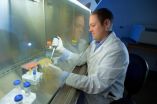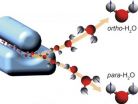(Press-News.org) Unlike electronic circuits, optical, or "photonic", circuits work with light rather than electricity, which makes them 10 to 100 times faster. They are also more energy-efficient because they show lower heat loss, better signal-to-noise ratios and are less susceptible to interference. Used especially for communications (e.g. fiber optics), optical circuits may use tiny optical cavities as 'switches' that can block or allow the flow of light, similarly to transistors in electronics. EPFL scientists have now fabricated and experimentally tested a silicon-based 'photonic crystal nanocavity' (PCN) that requires an unprecedentedly low amount of energy to operate as a switch. The findings, which have significant implications for the future of optical technologies, are published in a paper that features on the cover of Applied Physics Letters.
Optical Circuits and Optical Cavities
Optical circuits control light the way an electrical circuit controls the flow of electricity. Compared to electrical circuits, optical systems show superior speed, energy-efficiency and stability. Already used in fiber optic communications, the field of applied photonics is making steady progress in developing optical circuits, which use nanoscale 'optical cavities' as switches or 'transistors' for controlling the flow of light.
Optical cavities confine light in a tiny space of a few nanometers. 'Squeezed' in such a small volume, a tiny amount of incoming light is enough to cause a small change in the wavelength of the trapped light, because of the optical properties of the material from which the cavity is made. These properties are referred to as "non-linear", meaning that if a small amount of light can make the optical cavity resonate, a higher light intensity can cause it to actually switch between two different states. This effect, called "optical bi-stability" is ultimately what makes the optical cavity to act as a switch for light.
One of the challenges in the design and development of optical circuits is their efficiency in terms of speed and energy consumption. These two features are linked together, as an optical circuit's total absorbed power depends on the energy required by a single 'switch' operation multiplied by the number of operations per second. Consequently, the most likely cavities to be implemented in an optical circuit must be designed for minimal switching energy.
A New, Low-Energy Transistor for Light
The groups of Romuald Houdré and Vincenzo Savona at EPFL have now designed, fabricated and successfully tested an optical cavity based on a 'photonic crystal nanostructure' (PCN), which requires a record-low energy to switch on and off. The PCN is made from a silicon slab, and combines a record-small size with a very high quality, or "Q", factor, which is a measurement of how long the PCN can retain light. The measured Q factor of the new PCN device is 500,000, meaning that an incoming photon will bounce back and forth inside the optical cavity five hundred thousand times before escaping.
A high Q factor means that photons spend more time inside the cavity. The new PCN also has a very small size, which produces a higher light intensity for the same energy. "The nonlinearity is proportional to the intensity and the effect is stronger if you allow for longer buildup times," explains Savona. "This is because light interacts longer with the material that provides the nonlinearity." The combination of a high Q factor with a small size is why the new PCN requires very low energy for acting as a switch.
"In this work we have achieved non-linear effects at a record-low intensity of light," says Romuald Houdré. "Our structure is also one of the smallest ever designed to show such record nonlinear properties, and it may be built using standard nanofabrication technology. This is a very important step along the road to optical circuits, as small size, speed and low power consumption are key requirements for the realization of an efficient optical switching nano-device."
INFORMATION:
Reference
Dharanipathy UP, Minkov M, Tonin M, Savona V, Houdré R. High-Q silicon photonic crystal cavity for enhanced optical nonlinearities. Applied Physics Letters 08 September 2014. DOI: 10.1063/1.4894441
A low-energy optical circuit for a new era of technology
2014-09-08
ELSE PRESS RELEASES FROM THIS DATE:
To admit or not to admit: Variation in hospitalizations from ER costs billions
2014-09-08
ANN ARBOR, Mich. — It sounds like the setup for a joke: Two identical patients go to two different hospital emergency entrances, complaining of the same symptoms.
But what happens next is no laughing matter, according to a new University of Michigan study published in the September issue of Health Affairs. While one patient may get treated and released from the emergency department, the other gets sent upstairs to a hospital bed – at a cost of tens of thousands of dollars.
In fact, doctors at one hospital may be as much as six times as likely to admit an emergency ...
Scientists reveal cell secret potentially useful for vaccines
2014-09-08
The best defense is a good offense, especially when it comes to the immune system. The troops that respond to an infection are split into two squadrons, and, until recently, it seemed that the two were independent, without much interaction.
Now, in a paper published this week in Nature Immunology, a team of scientists from the Virginia Tech Carilion Research Institute and the University of Alabama at Birmingham say that the immunology boot camp is more communication-intensive than initially thought — a discovery that could help efforts to produce more effective vaccines.
"We ...
Women and health professionals spark new cycle of improving maternal and newborn health
2014-09-08
Demand for better care by women linked with the expansion of basic services, rather than political pressure, has helped to improve midwifery services in low to middle-income countries, according to international research involving the University of Southampton.
An examination of maternal and newborn health systems for the Lancet Series on Midwifery found that after initial investment in maternal and newborn health infrastructure, a virtuous cycle developed in these countries – with increased demand for care leading to the deployment of more midwives, better services, ...
Facial plastic surgery can safely address the major aspects of aging in 1 operation
2014-09-08
AUGUSTA, Ga. – A total facial rejuvenation that combines three procedures to address the multiple signs of an aging face and neck can be performed safely at one time, a new study shows.
Total facial rejuvenation, which combines an extensive facelift to tighten skin and muscle; specialized, midface implants to restore fullness; and laser resurfacing to reduce skin's irregular texture and discoloration, can be safely performed at one time, reports Dr. Achih H. Chen, facial plastic surgeon.
Chen, Director of Facial Plastic and Reconstructive Surgery at the Medical ...
Enigmatic Viking fortress discovered in Denmark
2014-09-08
It is the first time for over 60 years that a new Viking fortress is found in Denmark, says curator Nanna Holm of The Danish Castle Centre. Søren Sindbæk, professor of medieval archeology at Aarhus University, explains: "The Vikings have a reputation as a berserker and pirates. It comes as a surprise to many that they were also capable of building magnificent fortresses. The discovery of the new Viking fortress is a unique opportunity to gain new knowledge about Viking war and conflicts, and we get a new chance to examine the Vikings' most famous monuments. " The previously ...
Bureaucracy consumes one-quarter of US hospitals' budgets, twice as much as other nations
2014-09-08
A study of hospital administrative costs in eight nations published today in the September issue of Health Affairs finds that hospital bureaucracy consumed 25.3 percent of hospital budgets in the U.S. in 2011, far more than in other nations.
Administrative costs were lowest (about 12 percent) in Scotland and Canada, whose single-payer systems fund hospitals through global, lump-sum budgets, much as a fire department is funded in the U.S.
The study is the first analysis of administrative costs across multiple nations with widely varying health systems. It was carried ...
Climate change to increase forest fire danger in Europe
2014-09-08
Climate change is expected to bring increased temperatures and longer droughts—conditions that will make forests more susceptible to fires.
By 2090, the area burned by forest fires in the European Union could increase by 200% because of climate change, according to a new study published in the journal Regional Environmental Change. However, preventive fires could keep that increase to below 50%, the study shows. Improved firefighting response could provide additional protection against forest fires.
The study was the first to examine adaptation to forest fire danger ...
Sun-powered desalination for villages in India
2014-09-08
CAMBRIDGE, Mass-- Around the world, there is more salty groundwater than fresh, drinkable groundwater. For example, 60 percent of India is underlain by salty water — and much of that area is not served by an electric grid that could run conventional reverse-osmosis desalination plants.
Now an analysis by MIT researchers shows that a different desalination technology called electrodialysis, powered by solar panels, could provide enough clean, palatable drinking water to supply the needs of a typical village. The study, by MIT graduate student Natasha Wright and Amos Winter, ...
New mechanism in gene regulation revealed
2014-09-08
The information encoded in our genes is translated into proteins, which ultimately mediate biological functions in an organism. Messenger RNA (mRNA) plays an important role, as it is the molecular template used for translation. Scientists from the Helmholtz Zentrum Muenchen and the Technische Universität Muenchen, in collaboration with international colleagues, have now unraveled a molecular mechanism of mRNA recognition, which is essential for understanding differential gene regulation in male and female organisms. The results are published in the renowned scientific journal ...
Researchers part water
2014-09-08
Using an "electric prism", scientists have found a new way of separating water molecules that differ only in their nuclear spin states and, under normal conditions, do not part ways. Since water is such a fundamental molecule in the universe, the recent study may impact a multitude of research areas ranging from biology to astrophysics. The research team from the Center for Free-Electron Laser Science (CFEL) – a collaboration of DESY, the Max Planck Society and Universität Hamburg – reported its results in the journal Angewandte Chemie International Edition.
At first ...




